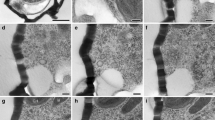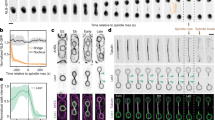Summary
During anaphase in thisNetrium, the reforming daughter nuclei hardly pause at the poles before they elongate and rapidly and smoothly move along the daughter cells in one of the grooves in the chloroplast. Ahead of each nucleus is a pointed mass of cytoplasm that is distinctly striated; straight, mobile strands of cytoplasm emanate from this region ahead of the nucleus. When the nucleus reaches the large vacuole that divides the two chloroplasts, it steadily slides over to the chloroplast surface distal to the cleavage furrow. It then stops moving and slowly expands into the normal interphase morphology.
Under the electron microscope, the chromosome-to-pole distance does not decrease much during anaphase (i.e., anaphase A is minimal) and so the half spindles remain about the same length by telophase. The poles of the open spindle are initially broad and contain typical spindle microtubules (MTs). These persist intact during anaphase and become focused upon a discrete Organizing Centre as the daughter nuclei reform. These MTs become a cone-shaped array that creates the pointed cytoplasmic mass ahead of the moving nucleus in live cells. Thus, this placoderm desmid behaves very likeClosterium during division and shows the lack of anaphase A, and the transformation of the telophase spindle into a MT-based motility system, now characteristic of many members of the Zygnematales.
Similar content being viewed by others
Abbreviations
- MT:
-
microtubule
- MTOC:
-
microtubule organizing centre
References
Bakker ME, Lokhorst GM (1987) Ultrastructure of mitosis and cytokinesis inZygnema sp. (Zygnematales, Chlorophyta). Protoplasma 138: 105–118
Carter N (1909) Studies on the chloroplasts of desmids. I. Ann Bot 33: 215–254
Fowke LC, Pickett-Heaps JD (1969 a) Cell division inSpirogyra. I. Mitosis. J Phycol 5: 240–259
— — (1969 b) Cell division inSpirogyra. II. Cytokinesis. J Phycol 5: 273–281
Kiermayer O (1968) Hemmung der Kern- und Chloroplastenmigration vonMicrasterias durch Colchicin. Naturwissenschaften 55: 299–300
— (1972) Beeinflussung der postmitotischen Kernmigration vonMicrasterias denticulata Breb. durch das Herbizid Trifluralin. Protoplasma 75: 421–426
Meindl U (1983) Cytoskeletal control of nuclear migration and anchoring in developing cells ofMicrasterias denticulata and the change caused by the anti-microtubular herbicide aminoprophosmethyl (APM). Protoplasma 118: 75–90
— (1986) Autonomous circular and radial motions of the nucleus inPleurenterium tumidum and their relation to cytoskeletal elements and the plasma membrane. Protoplasma 135: 50–66
Pickett-Heaps JD (1972 a) Cell division inCosmarium botrytis. J Phycol 8: 343–360
— (1972 b) Cell division inKlebsormidium subtilissimum (formerlyUlothrix subtilissima) and its possible phylogenetic significance. Cytobios 6: 167–183
— (1975) Green algae: structure, function and evolution in selected genera. Sinauer, Sunderland, Mass
— (1981) Cell division inClosterium. 16mm color film with sound, 15min. Cytographics, School of Botany, University of Melbourne, Parkville, Vic, Australia
— (1983) Valve morphogenesis and the Microtubule Center in three species of the diatomNitzschia. J Phycol 19: 269–281
—, Fowke LC (1970) Mitosis, cytokinesis and cell elongation in the desmidClosterium littorale. J Phycol 6: 189–215
—, Marchant HJ (1972) The phylogeny of the green algae. A new proposal. Cytobios 6: 255–264
—, Tippit DH, Leslie R (1980) Light and electron microscopic observations on cell division in two large pennate diatoms,Hantzschia andNitzschia. I. Mitosis in vivo. Eur J Cell Biol 21: 1–11
—, Wetherbee R (1987) Spindle function in the green algaMougeotia: absence of anaphase A correlates with postmitotic nuclear migration. Cell Motil Cytoskeleton 7: 68–77
Smith GW (1950) The freshwater algae of the United States. McGraw-Hill, New York
Stewart KD, Mattox KR (1975) Comparative cytology, evolution and classification of the green algae with some consideration of the origin of other organisms with chlorophyll a and b. Bot Rev 41: 104–135
Waris H (1953) The significance for algae of chelating substances in the nutrient solution. Physiol Plant 6: 538
West W, West GS (1904) A monograph of the British Desmidaceae, vol 1. Adlard & Son, London
Author information
Authors and Affiliations
Additional information
Dedicated to the memory of Professor Oswald Kiermayer
Rights and permissions
About this article
Cite this article
Jarman, M., Pickett-Heaps, J. Cell division and nuclear movement in the saccoderm desmidNetrium interruptus . Protoplasma 157, 136–143 (1990). https://doi.org/10.1007/BF01322646
Received:
Accepted:
Issue Date:
DOI: https://doi.org/10.1007/BF01322646




